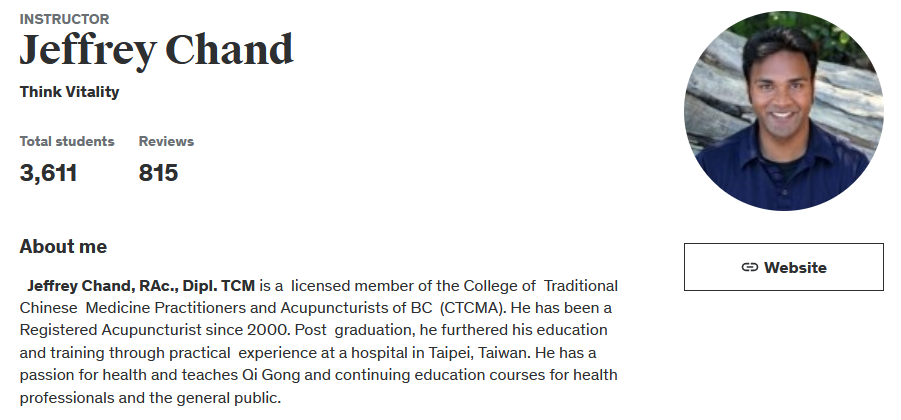Hey there! If you’re interested in enhancing your massage therapy skills with some acupressure and meridian massage techniques, then you might want to check out this Udemy course: Acupressure and Meridian Massage Techniques by Jeffrey Chand. It’s designed to help you relieve muscle tension, acute pain, and stress using simple and effective techniques from Traditional Chinese Medicine (TCM).
Instructor Reputation
When it comes to learning a specialized skill like acupressure and meridian massage, having a knowledgeable and experienced instructor makes all the difference. Jeffrey Chand, the instructor of this Udemy course, is an absolute gem in the field of Traditional Chinese Medicine (TCM). Let’s dive a bit deeper into why he’s such a great guide for this journey.

Jeffrey Chand holds a Diploma in Traditional Chinese Medicine and is a licensed member of the College of Traditional Chinese Medicine Practitioners and Acupuncturists of BC (CTCMA). He’s been a Registered Acupuncturist since the year 2000, which means he’s been honing his craft for over two decades. This extensive experience is evident in his teaching style and the depth of knowledge he shares in the course.
One of the standout aspects of Jeffrey’s background is his practical experience in a hospital setting in Taipei, Taiwan. This international experience not only deepened his understanding of TCM but also exposed him to a wide variety of cases and treatment methods. This global perspective enriches the course content, giving students insights that go beyond textbook knowledge.
Jeffrey’s passion for health and education is palpable. He teaches Qi Gong and various continuing education courses for health professionals and the general public. His commitment to teaching is reflected in his impressive instructor rating of 4.8 out of 5 stars. With over 800 reviews and more than 3,600 students, it’s clear that many people have benefited from his expertise.
Students often praise Jeffrey for his engaging teaching style and his ability to make complex concepts accessible. Reviews highlight his clear explanations, thoughtful presentation, and the practical applicability of the techniques he teaches. For instance, one student mentioned how the course helped them incorporate simple but effective TCM techniques into their massage practice, enhancing their treatments and providing better outcomes for their clients.
In short, Jeffrey Chand is a seasoned professional with a wealth of knowledge and a genuine passion for teaching. His background, experience, and teaching style make him the perfect instructor for this course, ensuring that you’ll be learning from one of the best in the field.
Course Structure
The structure of Acupressure and Meridian Massage Techniques is meticulously designed to provide a comprehensive and engaging learning experience. It’s organized into eight well-thought-out sections that guide you through the fundamentals of TCM and the practical application of acupressure and meridian massage techniques. Let’s take a closer look at each section and what you can expect to learn.
Section One: Short Introduction
The course kicks off with a brief introduction that sets the stage for what’s to come. Jeffrey provides an overview of the course objectives, outlining what you’ll learn and how it will benefit your practice. This section is a great way to get acquainted with the course layout and the instructor’s teaching style.
Section Two: Basic Principles of Traditional Chinese Medicine (TCM)
In this section, you’ll dive into the foundational concepts of TCM. Jeffrey covers essential topics such as yin-yang theory, the concept of Qi (the vital life force), and basic TCM diagnostic principles. Understanding these core concepts is crucial as they form the theoretical backbone of the practical techniques you’ll learn later in the course. Jeffrey’s explanations are clear and accessible, making complex theories easy to grasp.

Section Three: Introduction to Meridian Theory
Here, you’ll explore the meridian system, which is central to TCM. Jeffrey explains the function and location of the meridians most relevant to massage therapy. You’ll learn about the pathways these energy channels follow through the body and their significance in maintaining health and balance. This section includes a handout summarizing the location, function, and use of the meridians, providing a handy reference tool for your practice.
Section Four: Acupressure Points
This section focuses on eight specific acupressure points that are particularly useful in massage therapy. Jeffrey demonstrates how to locate these points accurately and explains their functions. You’ll learn both static pressure (acupressure) and moving pressure (massage along the meridian) techniques. The accompanying handout summarizes the key information, making it easy to review and integrate into your treatments.
Section Five: Practical Application and Case Study
After covering the theoretical and practical aspects, this section ties everything together with a sample case study. Jeffrey walks you through a real-life scenario, showing how to apply the techniques you’ve learned to treat a client. This practical demonstration helps solidify your understanding and gives you confidence in using these methods in your own practice.
Section Six: Course Handouts
This section is a treasure trove of additional resources. You can download and print various handouts that summarize the course content. These materials are invaluable for review and can serve as quick reference guides when you’re working with clients.
High-Definition Video Tips
To ensure you get the most out of the video lectures, the course includes tips on how to watch the videos in high definition. Jeffrey explains how to adjust the video quality settings on Udemy to 720p and how to view the lectures in full screen for the best viewing experience. This attention to detail enhances your learning experience, ensuring you don’t miss any important visual cues.
Overall, the course structure is thoughtfully designed to build your knowledge step-by-step, combining theory with practical application. Each section is carefully crafted to ensure you not only understand the concepts but also feel confident in applying the techniques. Whether you’re a massage therapist, physiotherapist, chiropractor, or simply someone interested in TCM, this course offers a comprehensive and engaging learning experience.
Content Quality
The content quality of the “Acupressure and Meridian Massage Techniques” course is exceptional, providing a rich blend of theoretical knowledge and practical skills that are both engaging and informative. Jeffrey Chand has meticulously curated the course material to ensure that students not only learn the fundamentals of TCM but also understand how to apply these principles effectively in their massage practices.

One of the standout features of this course is its high-definition video lectures. Jeffrey takes the time to explain complex concepts in a clear and concise manner, making them accessible to both beginners and seasoned practitioners. The videos are professionally produced, ensuring that every detail is visible and easy to follow. This attention to quality makes a significant difference in how well students can grasp and retain the information.
The course begins with a comprehensive introduction to the basic principles of Traditional Chinese Medicine. Jeffrey covers essential topics such as yin-yang theory, the concept of Qi, and TCM diagnostic principles. These foundational concepts are crucial for understanding the more advanced techniques taught later in the course. Jeffrey’s ability to break down these complex ideas into easily digestible parts is one of the reasons why the content quality is so high.
Moving on to the practical aspects, the course offers detailed instructions on locating and using meridians and acupressure points. Jeffrey provides both static pressure (acupressure) and moving pressure (massage along the meridian) techniques, demonstrating each one with precision. The accompanying handouts are well-designed and serve as excellent reference materials that students can use long after completing the course.
Another highlight is the practical application section, where Jeffrey walks through a sample case study. This real-life scenario ties together all the theoretical and practical knowledge, showing students how to apply what they’ve learned in a clinical setting. This hands-on approach is invaluable for reinforcing the material and building confidence.
Student reviews consistently praise the thoroughness and clarity of the course content. Many have found the techniques taught to be highly effective in their practices, helping them to relieve pain and tension in their clients more efficiently. The positive feedback and high ratings from students are a testament to the quality of the content provided in this course.
Overall Course Rating – 9/10
After thoroughly exploring the “Acupressure and Meridian Massage Techniques” course, I would rate it a solid 9 out of 10. This high rating reflects the course’s comprehensive and practical approach to teaching acupressure and meridian massage, as well as the expertise and passion of the instructor, Jeffrey Chand.

One of the primary reasons for this high rating is the course’s ability to cater to a wide range of students, from complete beginners to seasoned health practitioners. Jeffrey’s teaching style is engaging and accessible, making complex TCM concepts easy to understand. His clear and concise explanations, combined with high-quality video production, ensure that students can follow along and grasp the material effectively.
The course structure is another significant factor contributing to the high rating. The logical progression from basic principles to advanced techniques ensures that students build a solid foundation before moving on to more complex topics. Each section is well-organized, with handouts and resources that enhance the learning experience and provide valuable reference materials.
Jeffrey’s practical approach is also commendable. The inclusion of a sample case study allows students to see how the techniques can be applied in real-life scenarios. This hands-on demonstration helps bridge the gap between theory and practice, giving students the confidence to use these methods in their own treatments.
Student feedback has been overwhelmingly positive, with many praising the course for its detailed content and practical applications. The few criticisms, such as the lack of extensive student handouts, are relatively minor and do not significantly detract from the overall quality of the course. Jeffrey’s responsiveness to student queries and his ongoing commitment to improving the course further boost its rating.
In conclusion, the “Acupressure and Meridian Massage Techniques” course by Jeffrey Chand is an excellent resource for anyone looking to enhance their massage therapy skills with TCM techniques. Its comprehensive content, high-quality production, and practical applications make it a valuable addition to any health practitioner’s toolkit. With a rating of 9 out of 10, this course comes highly recommended for those interested in expanding their knowledge and skills in acupressure and meridian massage.



